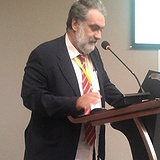Feature Review Papers in Applied Physics
A special issue of Applied Sciences (ISSN 2076-3417). This special issue belongs to the section "Applied Physics General".
Deadline for manuscript submissions: 20 July 2024 | Viewed by 2480
Special Issue Editors
Interests: earthquake precursory phenomena; physics of earthquakes; earthquake prediction; natural time analysis; thermodynamics of point defects; complex systems physics; nonlinear dynamics
Special Issues, Collections and Topics in MDPI journals
Interests: time series analysis; molecular dynamics; condensed matter physics; stochastic processes; density functional theory; time series; neural networks; deep learning; solid state physics; molecular dynamics simulation
Special Issue Information
Dear Colleagues,
We now stand almost one year after the end of the COVID-19 pandemic with the will to continue our pursuit of the physical law in science and of innovation in engineering. This Special Issue focuses on the recent advances in applied physics. and aims to collect high-quality systematic reviews in this field.
All applications of physics aiming to solve practical problems are included. All articles that employ physics or present physics research focused on (i) developing new methods and/or technologies or (ii) solving engineering problems are welcome.
The topics of interest for this Special Issue include, but are not limited to, astrophysics, atmosphere, biophysics, cardiology, complex systems, disaster mitigation, earthquakes, geophysics, lasers, materials, medicine, optics, photonics, plasmas, reliability, safety, security, semiconductors, and spectroscopy.
We hope all published papers will be widely read, highly influential and promote the most recent advances in the field.
Prof. Dr. Nicholas Vassiliou Sarlis
Dr. Stavros-Richard G. Christopoulos
Guest Editors
Manuscript Submission Information
Manuscripts should be submitted online at www.mdpi.com by registering and logging in to this website. Once you are registered, click here to go to the submission form. Manuscripts can be submitted until the deadline. All submissions that pass pre-check are peer-reviewed. Accepted papers will be published continuously in the journal (as soon as accepted) and will be listed together on the special issue website. Research articles, review articles as well as short communications are invited. For planned papers, a title and short abstract (about 100 words) can be sent to the Editorial Office for announcement on this website.
Submitted manuscripts should not have been published previously, nor be under consideration for publication elsewhere (except conference proceedings papers). All manuscripts are thoroughly refereed through a single-blind peer-review process. A guide for authors and other relevant information for submission of manuscripts is available on the Instructions for Authors page. Applied Sciences is an international peer-reviewed open access semimonthly journal published by MDPI.
Please visit the Instructions for Authors page before submitting a manuscript. The Article Processing Charge (APC) for publication in this open access journal is 2400 CHF (Swiss Francs). Submitted papers should be well formatted and use good English. Authors may use MDPI's English editing service prior to publication or during author revisions.
Keywords
- astrophysics
- atmospheric physics
- biophysics
- cardiology
- complex systems
- disaster mitigation
- earthquakes
- geophysics
- lasers
- materials
- medicine
- optics
- photonics
- plasmas
- reliability
- safety
- security
- semiconductors
- spectroscopy






